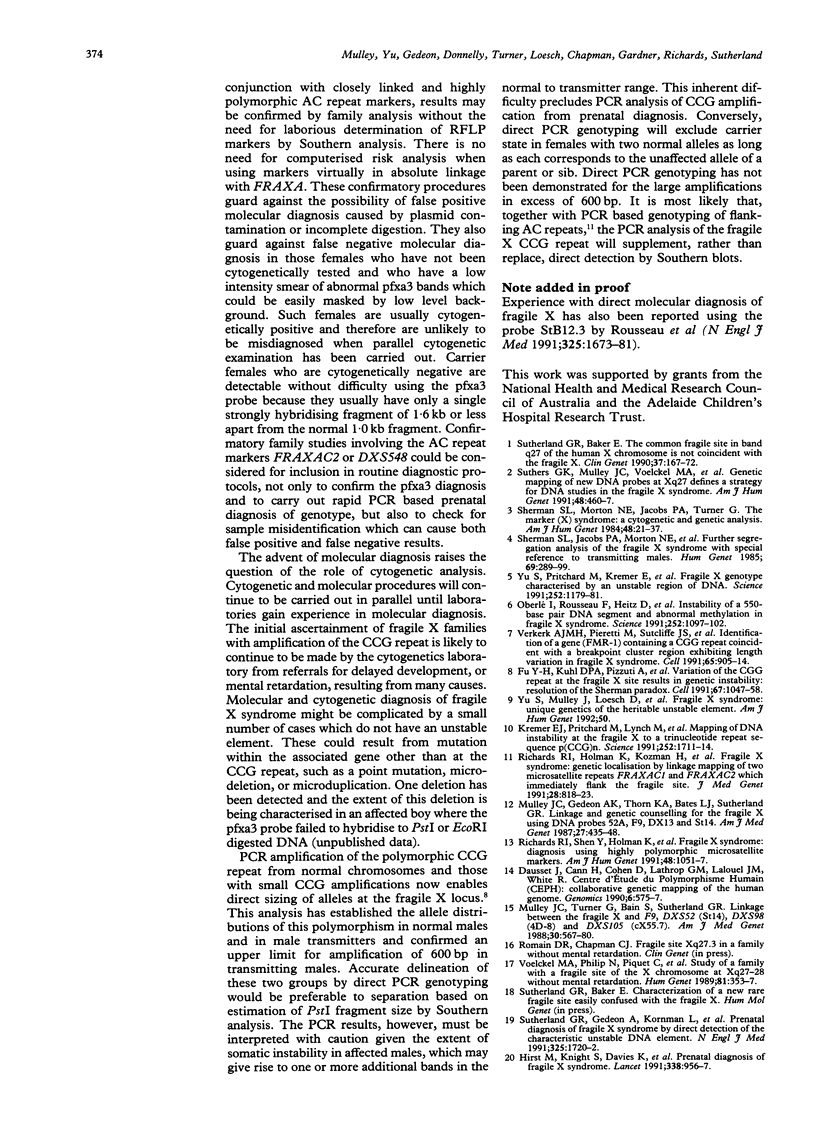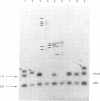Abstract
The utility of the pfxa3 probe for direct molecular diagnosis of the fragile X (FRAXA) has been established. This probe detects amplification of an unstable DNA element consisting of variable length CCG repeats. The size of the amplified fragment is correlated with phenotype and was determined using PstI digested DNA in family members. In 35 families with the fragile X, there was correspondence in 183 cases between the presence of an amplified unstable element and the presence of the fragile X chromosome independently determined by cytogenetics, position in the pedigree, or linked DNA markers flanking the fragile X. There was also correspondence in 124 cases between the presence of the normal 1.0 kb PstI fragment and absence of the fragile X chromosome independently determined by linked flanking markers. Six additional families considered to be isolated cases of 'fragile X' had been diagnosed before recognition of FRAXD. The pfxa3 probe confirmed the cytogenetic diagnosis in three families, the other three being rediagnosed as non-fragile X. A further two families had consistent expression of a different folate sensitive fragile site, FRAXE, close to FRAXA but not associated with fragile X syndrome and not detectable with the pfxa3 probe. Subsequent referrals were received from additional family members or from members of new families for whom carrier status had not been predetermined by linked markers. Direct pfxa3 diagnosis for the 135 females within these 222 additional cases was confirmed by dosage analysis with the control probe pS8.(ABSTRACT TRUNCATED AT 250 WORDS)
Full text
PDF






Images in this article
Selected References
These references are in PubMed. This may not be the complete list of references from this article.
- Dausset J., Cann H., Cohen D., Lathrop M., Lalouel J. M., White R. Centre d'etude du polymorphisme humain (CEPH): collaborative genetic mapping of the human genome. Genomics. 1990 Mar;6(3):575–577. doi: 10.1016/0888-7543(90)90491-c. [DOI] [PubMed] [Google Scholar]
- Fu Y. H., Kuhl D. P., Pizzuti A., Pieretti M., Sutcliffe J. S., Richards S., Verkerk A. J., Holden J. J., Fenwick R. G., Jr, Warren S. T. Variation of the CGG repeat at the fragile X site results in genetic instability: resolution of the Sherman paradox. Cell. 1991 Dec 20;67(6):1047–1058. doi: 10.1016/0092-8674(91)90283-5. [DOI] [PubMed] [Google Scholar]
- Kremer E. J., Pritchard M., Lynch M., Yu S., Holman K., Baker E., Warren S. T., Schlessinger D., Sutherland G. R., Richards R. I. Mapping of DNA instability at the fragile X to a trinucleotide repeat sequence p(CCG)n. Science. 1991 Jun 21;252(5013):1711–1714. doi: 10.1126/science.1675488. [DOI] [PubMed] [Google Scholar]
- Mulley J. C., Gedeon A. K., Thorn K. A., Bates L. J., Sutherland G. R. Linkage and genetic counselling for the fragile X using DNA probes 52A, F9, DX13, and ST14. Am J Med Genet. 1987 Jun;27(2):435–448. doi: 10.1002/ajmg.1320270222. [DOI] [PubMed] [Google Scholar]
- Mulley J., Turner G., Bain S., Sutherland G. R. Linkage between the fragile X and F9, DXS52 (St14), DXS98 (4D-8) and DXS105 (cX55.7). Am J Med Genet. 1988 May-Jun;30(1-2):567–580. doi: 10.1002/ajmg.1320300158. [DOI] [PubMed] [Google Scholar]
- Prenatal diagnosis of fragile X syndrome. Lancet. 1991 Oct 12;338(8772):956–958. [PubMed] [Google Scholar]
- Richards R. I., Holman K., Kozman H., Kremer E., Lynch M., Pritchard M., Yu S., Mulley J., Sutherland G. R. Fragile X syndrome: genetic localisation by linkage mapping of two microsatellite repeats FRAXAC1 and FRAXAC2 which immediately flank the fragile site. J Med Genet. 1991 Dec;28(12):818–823. doi: 10.1136/jmg.28.12.818. [DOI] [PMC free article] [PubMed] [Google Scholar]
- Richards R. I., Shen Y., Holman K., Kozman H., Hyland V. J., Mulley J. C., Sutherland G. R. Fragile X syndrome: diagnosis using highly polymorphic microsatellite markers. Am J Hum Genet. 1991 Jun;48(6):1051–1057. [PMC free article] [PubMed] [Google Scholar]
- Rousseau F., Heitz D., Biancalana V., Blumenfeld S., Kretz C., Boué J., Tommerup N., Van Der Hagen C., DeLozier-Blanchet C., Croquette M. F. Direct diagnosis by DNA analysis of the fragile X syndrome of mental retardation. N Engl J Med. 1991 Dec 12;325(24):1673–1681. doi: 10.1056/NEJM199112123252401. [DOI] [PubMed] [Google Scholar]
- Sherman S. L., Jacobs P. A., Morton N. E., Froster-Iskenius U., Howard-Peebles P. N., Nielsen K. B., Partington M. W., Sutherland G. R., Turner G., Watson M. Further segregation analysis of the fragile X syndrome with special reference to transmitting males. Hum Genet. 1985;69(4):289–299. doi: 10.1007/BF00291644. [DOI] [PubMed] [Google Scholar]
- Sutherland G. R., Baker E. The common fragile site in band q27 of the human X chromosome is not coincident with the fragile X. Clin Genet. 1990 Mar;37(3):167–172. doi: 10.1111/j.1399-0004.1990.tb03498.x. [DOI] [PubMed] [Google Scholar]
- Sutherland G. R., Gedeon A., Kornman L., Donnelly A., Byard R. W., Mulley J. C., Kremer E., Lynch M., Pritchard M., Yu S. Prenatal diagnosis of fragile X syndrome by direct detection of the unstable DNA sequence. N Engl J Med. 1991 Dec 12;325(24):1720–1722. doi: 10.1056/NEJM199112123252407. [DOI] [PubMed] [Google Scholar]
- Verkerk A. J., Pieretti M., Sutcliffe J. S., Fu Y. H., Kuhl D. P., Pizzuti A., Reiner O., Richards S., Victoria M. F., Zhang F. P. Identification of a gene (FMR-1) containing a CGG repeat coincident with a breakpoint cluster region exhibiting length variation in fragile X syndrome. Cell. 1991 May 31;65(5):905–914. doi: 10.1016/0092-8674(91)90397-h. [DOI] [PubMed] [Google Scholar]
- Voelckel M. A., Philip N., Piquet C., Pellissier M. C., Oberlé I., Birg F., Mattei M. G., Mattei J. F. Study of a family with a fragile site of the X chromosome at Xq27-28 without mental retardation. Hum Genet. 1989 Mar;81(4):353–357. doi: 10.1007/BF00283690. [DOI] [PubMed] [Google Scholar]




